How the Weston Woods Was Won
Weston (Google Maps location)
March 13, 2010
Update: Morton Schindel passed away in 2016 at the age of 98. This place no longer exists as we visited it, and that makes my wife and I very, very sad. We both loved meeting Mort and could have spent a week with him in Weston. His house and cottage were sold in late 2018 to some lucky folks. I really hope the mountains of art and artifacts have been catalogued and stored somewhere proper, as they deserve a museum of their own someday.
![]()
It’s not every day you’ll read a CTMQ post about my “favorite museum thus far.” But here it is and here you are: As of this writing, after visiting 210 museums for this “quest,” the unknown and not-even-really-a-real-museum-yet Weston Woods hidden away deep within the Weston woods (seriously) is exactly that: My personal favorite museum in Connecticut. Or at least my favorite museum experience.
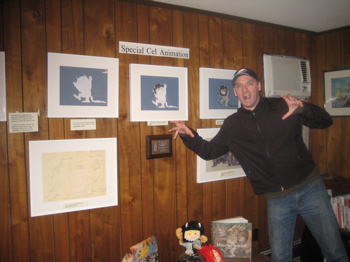
I’ll give you a minute to digest that. And more moments if you want to read my top 10 museums list of my second hundred museums visited.
And then I’ll go one further: Hoang loved this place too. And Damian was even really good for the two hours we were there! AND, to top it off, we visited during an absolute monsoon – a storm which brought death and destruction mere miles from Weston Woods. And we STILL had a great time. That’s how cool this place is.

Actually, I should rephrase that… The number one reason Weston Woods is great is because of Morton Schindel. Mort IS Weston Woods and Weston Woods IS Mort Schindel.
Now, I realize there is a chance you don’t know who Mort Schindel is or what Weston Woods is all about. And it’s clear my pictures don’t really tell the story either. It’s also clear – to me – that I’m not equipped to even scratch the surface of everything Mort and Weston Woods has done over the years. For that, I strongly encourage you to seek out the excellent book, The Story of Weston Woods (Imagination and Innovation) by John Cech. It’s provides a great history and overview of the company and its groundbreaking work.
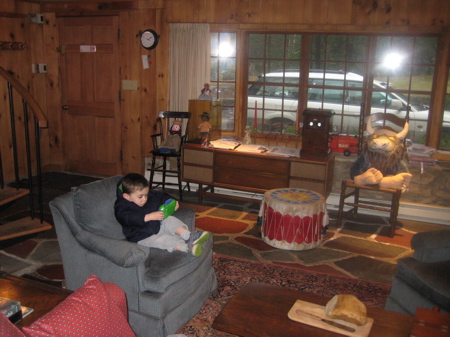
As a way of introducing Weston Woods to you, let’s check out Booklist’s review of Cech’s book:
Imagination and Innovation is the perfect title for the Weston Woods story, because the company was built on just that. Mort Schindel, the heart and founder of Weston Woods, came from a privileged background in the 1920s. Destined for a career in economics, Schindel was sidelined with tuberculosis. While Schindel was recuperating, his doctor suggested that he pursue a career in art, which led him to film and a whole new world of children’s media.
Cech, a writer, critic, and teacher of children’s literature, has the background to write Weston Woods’ story, and he fills the narrative with portraits of authors, artists, and Schindel himself. The picture books that have been filmed with the studio’s iconographic technique (a process by which the cameras create a sense of movement by panning and highlighting details in the book’s original illustrations) are some of the most recognized, including titles such as Make Way for Ducklings and The Man Who Walked between Towers.
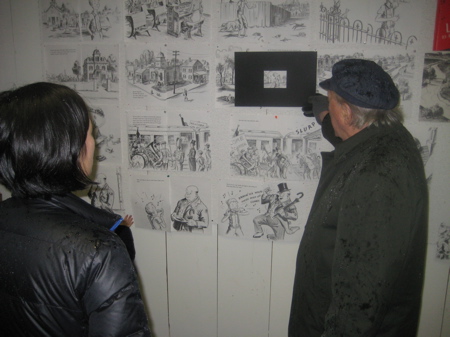
Cech has included animation cells, archival photographs, storyboards, advertisements, and pictures of mementos of the films as well as a chronology of the company and a filmography. Throughout his career, Schindel and Weston Woods have changed with the times, moving from film to filmstrips to videos to DVDs, and have expanded their business to include a mobile cinema, international productions, and a museum to house all of their artifacts, but throughout it all, they have stuck to their mission of quality and integrity. Cech’s book is a fine tribute to both the company and its founder and will be popular with anyone with a fondness for film or children’s literature.
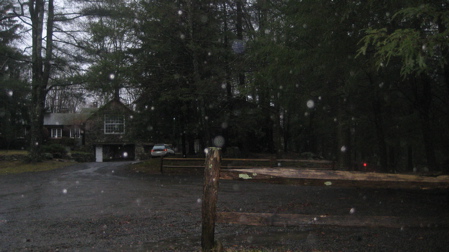
Did you catch that bit about “a museum to house all of their artifacts?” I did. In fact, somehow I caught it a few years ago – and I’m sure glad I did. I can’t remember where I first read about the museum, but I did reach out to Mort (I called him Mr. Schindel throughout my visit, though he insisted on Mort. Hoang fondly refers to him as “Morty” when we wistfully recount our visit. And that reminds me that he fondly referred to Hoang as “Juan” all afternoon. We let him get away with it though. He’s Mort!) and he replied that he’d love to have me visit. True to his nature, he never failed to mention that I simply must bring Damian along, as he’d enjoy it as well.
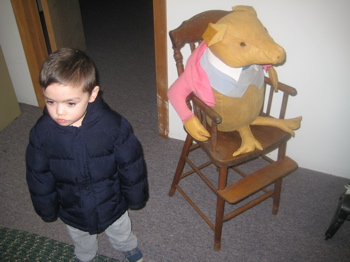
At least a year went by before I contacted him again with plans to be in the area – for a visit to the excellent Stepping Stones Museum down in Norwalk and perhaps some other stops for the purposes of CTMQ.
Mort was game and so were we, so we made plans. At this point I should tell you a little about the town of Weston since I’m not sure I’ll have the chance to do so elsewhere on the site – and I just think it’s so interesting. Especially as it relates to the whole issue of whether Weston Woods is a museum or not. First, it’s most definitely a museum; it’s just not really “open for business” to all comers yet. There are many reasons for this but the biggest one is the crazy zoning laws of Weston. In Weston, you cannot open a business.
Say what?
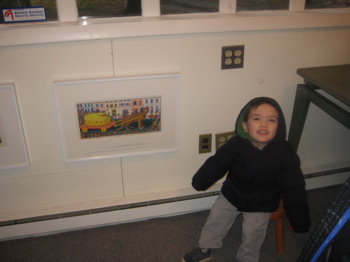
There are almost no businesses in Weston. There’s nothing in Weston. Lots of very reclusive, very rich people live there; we drove past WWE billionare’s estates which is very near the Rolling Stones’ Keith Richards’ estate. Weston (not Greenwich, not Darien, not New Canaan) is the richest town in the richest county (Fairfield) in the country. It’s near impossible to see any of the houses because they are all set back so far from the road – which is the result of part of the town ordinances.
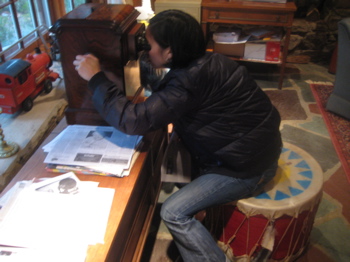
A 1985 New York Times article about the town begins, “Residents of Weston don’t want anyone to know they are there.” (Keep in mind those prices cited in the article are 1985 numbers. Suffice it to say, they are a joke today.) I think that states the attitude of Weston perfectly.
I’m fascinated with Weston. It never had a railroad or major road through it, so it never became commercialized. One old shopping center in the town “center” with a few stores exists, but it’s been there for a hundred years and is allowed to remain via a grandfather clause. Get this: every single lot in town MUST be at least 2 acres minimum. Who else lives/has lived there? James Thurber, Robert Redford, Jose Feliciano, Bette Davis and, get this, Rodney everlovin’ Dangerfield.
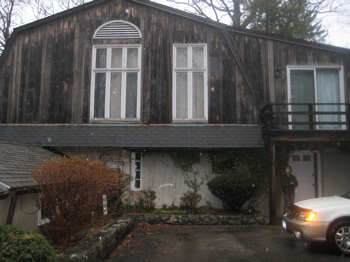
So for a museum to exist in town, a protracted fight with the town’s zoning commission had to take place. Would this museum be a commercial venture? Would you like to put a sign out on the road alerting passersby to this museum’s existence? (No way!) Would this museum bring busloads of children from those nearby dens if inequity, Easton, Wilton and God forbid, Westport?! (I hope so.) Spend a couple minutes reading the minutes of the Planning and Zoning meeting regarding the proposed museum. When reading about the town’s “concerns,” keep in mind that the WW complex is deep in the middle of the woods with no neighbors I could see. Amazing.
2019 Update: They built a bunch of houses on the former Weston Woods property, which is what the linked document above is talking about, which is weird.
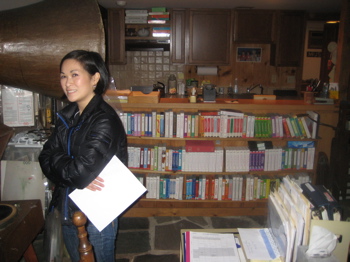
I don’t believe the town finally granted WW the necessary permits to move forward with the museum. And then Mort passed away. Mort’s intentions were to keep it very low key and to pretty much keep it as an appointment only type of place. He has some docents-in-training and some helpers to sort through the massive collections to figure out how to best present everything. My man Mort is now 92 (or so) as of this writing, so it’s no secret that he can’t do everything himself.
And now you know the story of how my favorite museum – that’s not really a museum yet – came to be in the town that hates development (for the right reasons, I might add.) So that leaves Mort’s story and, you know, what the heck this museum is all about.
Two things have ever happened in Weston to put it on the map – one, the 1807 Weston Meteorite that famously fell in town and Mort Schindel.
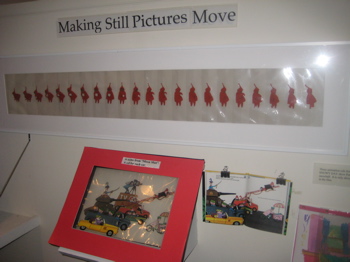
In a word, Mort is awesome. He was so nice to us and so sweet with Damian. He’s also sharp as a tack and comes armed with a good sense of humor. We immediately got along and within minutes, both Hoang and I wanted to spend a week with him. (I was offered, by the way, the possible use of one of the artist-in-residence cabins if I were to write a real article about Weston Woods someday.)
After graduating from Penn and the Wharton School of Finance AND Columbia, he contracted tuberculosis which he “credits” for his chosen life’s work. Destined for years of inactivity, he pursued the life of an artist. Since he liked photography, he figured he’d do something with that. Then he married a woman from a wealthy family (Bamberger’s department stores) and went to work for Teaching Films Inc which then went bankrupt. So he opened his own little film company called Key Productions but found that no one felt there was a market for children’s films. He made some educational films for them but he had noticed that children who read books in libraries rarely selected “Dick and Jane”, but instead gravitated toward colorful picture books – for which no films really existed.
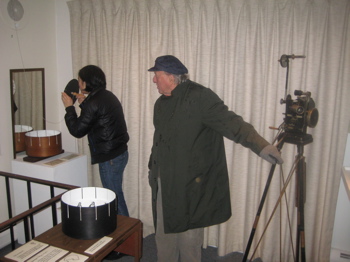
His idea on hold, Mort went to Turkey and shot and showed films via the US Information Service for a couple years and then in 1953, he ended up in Weston and started up Weston Woods.
At the time, I’m sure Weston looked exactly as it does now. The towns on the train lines to New York (Westport, Darien, New Canaan) were where the advertising executives from New York began settling (just like on “Mad Men”) in their fancy mid-century modern houses. Writers and artists had to settle for Weston and its decidedly homier feel – and since they didn’t need to commute to New York, it was perfect.
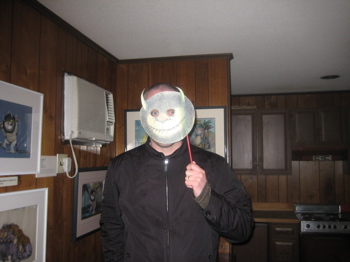
And now we’re finally up to the part of this page where a light bulb will go on over your head in recognition (finally) of what Weston Woods is/was. (It’s now a wholly owned subsidiary of Scholastic, Inc. down in Norwalk, CT.)
It was awesome. It was pioneering. It was important.
Since its beginning in the early 1950’s, Weston Woods has produced more than 500 films and film strips, beginning with Andy and the Lion (1954), adapted from the 1939 Caldecott Honor book by James Daugherty. Weston Woods films were shown at the Museum of Modern Art in 1956, and that same year the films had their CBS television premiere on “Captain Kangaroo.” In 1963, the studio released its first animated film, The Snowy Day, adapted from the 1962 Caldecott Medal book by Ezra Jack Keats, and the following year, it produced a documentary. The Lively Art of Picture Books, for the American Library Association. The Doughnuts (1963) was a 28-minute live-action comedy based on a chapter from Robert McCloskey’s Homer Price (1943). Beginning in 1968, Gene Deitch became the leading animation director for Weston Woods, working from his studio in Czechoslovakia with his wife, Zdenka Deitchova.
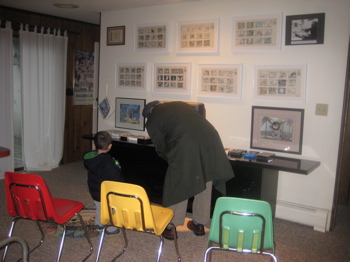
Whoa, Wikipedia, that was a lot to absorb! Let’s slow it down a bit…
Weston Woods is divided into a few different buildings. We met Mort in a homey cottage-like building with couches and a little kitchenette. Here, we learned how the property was originally built. (I forget the details, because I didn’t notes preferring instead to just enjoy being in the man’s presence.) Where the stone and cedar logs came from and the difficulties encountered while building. We talked a bit about Mort’s rich life, his travels, his current wife and children’s author Cari Best and, amazingly, he seemed just as interested in CTMQ and how it came about and how I do what I do. The man KNEW me! He’d read some stuff on here and somehow found a few articles I’d written for Museum magazine. I was enamored.
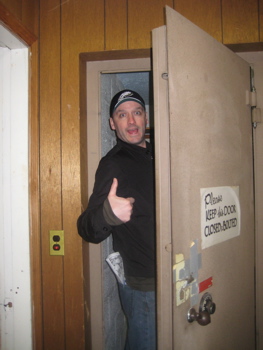
As we talked, my eyes wandered around the room and I started noticing all sorts of collectibles from books and movies I recognized. As I’d come to learn, Mort is incredibly modest about his work and his collection. This, above all else, was what blew me away about Weston Woods. The sheer enormity and priceless nature of the collection is mind-blowing and yet, it was all presented to us in a very low-key sort of way. I loved that.
Like above. That’s an antique Edison phonograph of some sort. I really wish I knew the model, because if I remember correctly, there are only a very few remaining working models in existence. The next thing we knew, Mort was playing some music through its enormous speaker thing. The records it plays are about ¾ of an inch thick! (See second picture above.) Who knows how much that thing is worth, but I’m sure it’s a pretty penny.
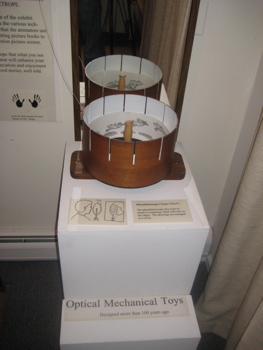
On the other side of the room was an old (I can’t believe I forget the name of these things) moving pictures thing where you spin the wheel and peer in to see the “movie.” And I bet that drum Hoang is sitting on is some artifact from some artist as well. The room was so warm and inviting – and it was so cold and rainy outside – we could have all just curled up with a fire and some great Weston Woods movies on the TV.
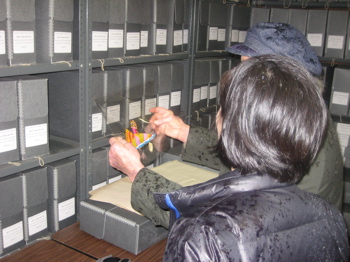
But alas, we pressed onward out into the gloom, for Weston Woods is housed in a few different buildings. At this point, the wonderful Mr. Schindel insisted we climb into his car for the short little drive down the driveway. An uncomfortable 60 seconds in the downpour ensued as we tried to insist on driving for Damian’s sake. Mort hated that idea and just started up his car. It’s not that we were worried he had no carseat, it’s that Damian sometimes needs things Damian-way. This was decidedly not Damian-way.
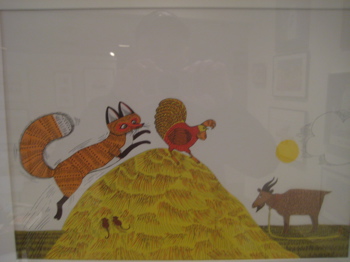
But he handled it fairly well and we did a 31-point turn and 9 second drive down the drive to the next building. Now, I have no idea what these buildings are named and keep in mind the museum was a work in progress during my visit, early in its organization. In this first building, we were treated to some art galleries, a little theater type room, the history of Weston Woods and some primers on the movie-making process and how some of the films the company was famous for came to be.
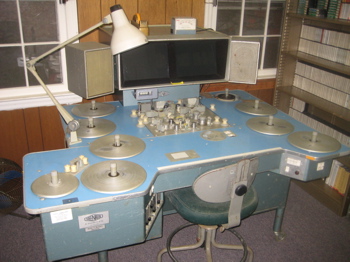
It is an absolute treasure-trove for anyone who has kids, read kids’ books, saw any of these movies or loves animation and/or films. Everywhere we turned was something wonderful and recognizable. The small studio (named for the woods surrounding Schindel’s Weston, CT, home) has produced more than 300 films and 450 filmstrips, videos, and audiocassettes, sold to more than 50,000 schools and libraries nationwide.
A whole room (there are many rooms here) is dedicated to the process of making the iconic “Where the Wild Things Are” original film you all must have seen at some point. Original cels by Maurice Sendak line the walls and the original film equipment from the 50’s and 60’s are set up around the room, giving an idea of the incredibly intricate and groundbreaking film techniques Schindel pioneered here at Weston Woods.
You see, my man Mort also came up with a creative way to better his productions. Having seen the financial and creative strains placed on authors and artists who were forced to accept one-time payment rights for their works, he soon came up with a better formula—children’s book creators would receive royalties and become integral in the film making process. And by “integral,” I mean they ventured up here to the woods in Weston and lived in the artist’s guest houses for a few weeks while overseeing their books and art turn into movies.
So yes, all those children’s authors you loved as a kid stayed here, hung out with Mort and helped shape the movies. Aside from Sendak, Robert McCloskey also spent lots of time here. (Many, many others have as well over the years. Heck, Meryl Streep just narrated “Chrysanthemum” a short while back. The list of Caldecott Award winners who walked these same halls is staggering.)
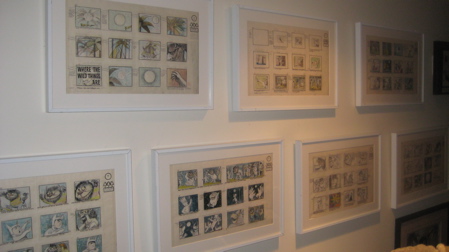
The neatest thing for us while visiting was seeing Damian light up at seeing some of his favorite characters and cels from some movies he enjoys.
I don’t think I knew which little films Damian enjoyed (and still does, at five years old) that came from Weston Woods. Some you may have never heard of like Rosie’s Walk and Trashy Town. If you watch them, you’ll see both employ the Weston Woods style; that is, they take the original book drawings and make them move. Another you surely know is Chicka Chicka Boom Boom – which has the distinction of being Damian’s only 4-sound “word” in Damianese (“Ch-Ch-B! B!”)
He, like all kids, loves this stuff. One of Damian’s favorite films, which doesn’t exist online, is Changes, Changes by Pat Hutchins. The film is really cool; since the book doesn’t have words, the creative wizards at Weston Woods – notably Gene Deitch – paced the movement to correspond to the beat of the music. For that, they used wooden instruments like the marimba, wood blocks and rattles.
To create the Harold and the Purple Crayon movie, Deitch developed a ridiculously painstaking process of backwards wiping a huge painting that an overlayed Harold moved over. Trust me, it’s crazy.
I mentioned that Robert McCloskey was a big part of Weston Woods’ growth. Several of his handmade puppets are housed here as well as, of course, hundreds of his drawings for some of those early films.
At this point, I realize that this page is way too long – but I’m skipping over huge chunks of Schindel’s ouevre. I feel badly about that, but I know you have stuff to do today. So let’s move on to the next building…
This next building houses an enormous collection of film equipment dating back to the birth of Weston Woods. Each innovation along the way (film to video to DVD) was incremental – and each piece of equipment they used along the way is cataloged and displayed. All sorts of cameras and sound equipment fill the various rooms. Entire rooms are filled with archived original animation cells from the hundreds of movies made right here.
In addition, there are also tables and cabinets filled with antique film and photo equipment. With each new room, I was blown away yet again by the breadth of Mort’s collections. Every type of electronic media has been preserved as well; like the first instant camera, the first digital sound recorder, the first VCR, old 8-tracks and 8-Track machines… On and on. When this place is a “real” museum, I’m sure this stuff will be presented in a more visitor-friendly way.
There was a table full of antique stereoscopes that – if you look closely in this picture you can see it –
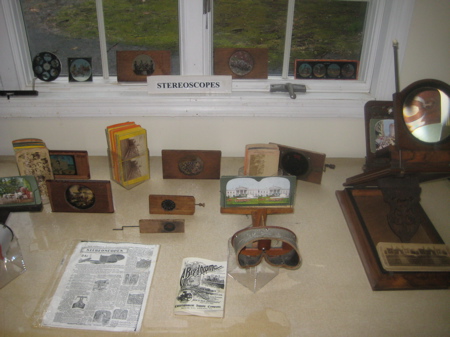
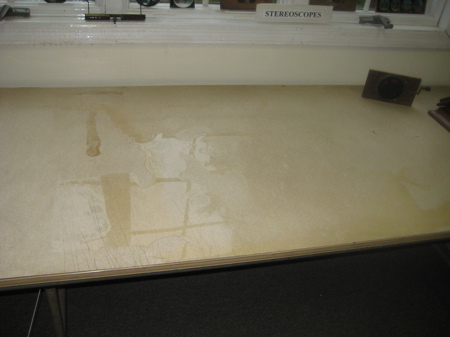
– the deluge had leaked through the roof and was pooling on the table! Hoang and I rescued the pieces and we moved along. All sorts of projectors, cameras and different types of film canisters fill another room. Laser discs, LP’s, and another area filled with every type of audio recording and playing device in history!
We were shown a small room with a huge old sound mixing machine and the little studio where the voice recordings for the books were made. I enjoy all these pictures where you can see Damian in the background poking and prodding the various machines. Now, I’m not going to assume you or your kids will be able to have such freedom if this place is ever open to the public, so please don’t promise your child that he or she will be able to push buttons on electronic historic artifacts.
As we wound our way back through the rooms, Mort led me into a secret locked room. In it, were thousands more light and temperature sensitive original pieces of artwork from the books and movies made here at Weston Woods. I cannot explain to you how extensive and incredible the collections are here.
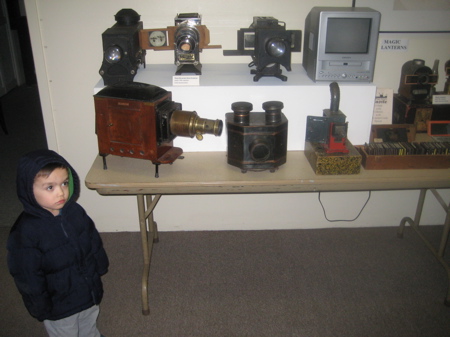
Oh yeah. Right. Mr Innocent…
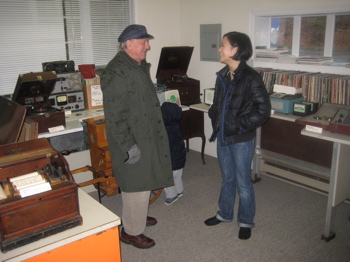
Hoang laughs it up with Mort to distract him from whatever Damian’s breaking behind him…
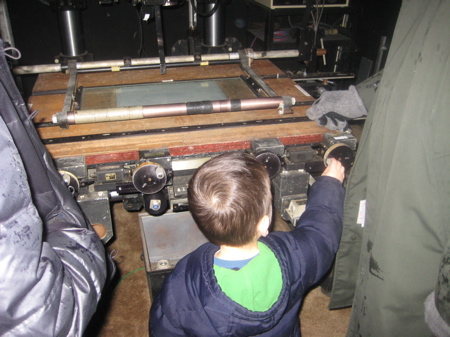
Hoang again distracts Mort… I wonder where Damian gets it from?
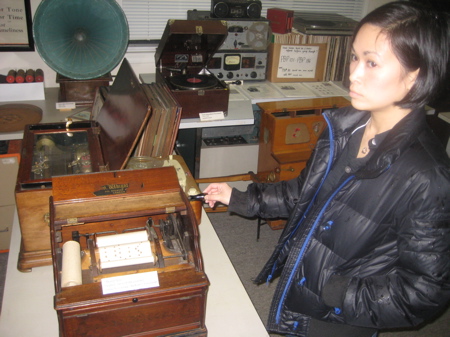
MMMMmm- hm
We reconvened back at the cottage to wrap up our visit. Mort, in his affable and endlessly kind way, prepared a sort of gift basket for us. He loaded Damian up with videotapes and gave me The Story of Weston Woods (Imagination and Innovation) by John Cech I mentioned way up at the top of this page. He even signed my book; now, I’m not one to usually have people sign stuff, but I felt honored to have Mr. Morton Schindel’s autograph.
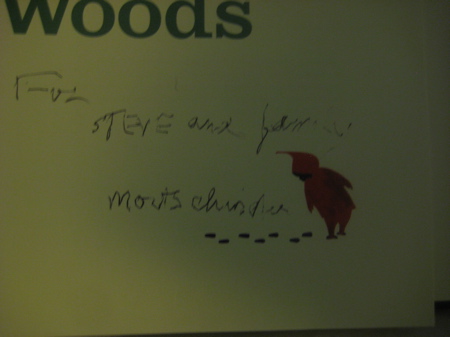
“To Steve and Family, Mort Schindel.” (Note, the pen didn’t work well and he was freezing and wet.)
I’ll end this endless post with a quick little tidbit that will give you some depth of knowledge about how much Mort and Weston Woods have done. The gifted videos were placed in a heavy duty plastic bag with a plastic snapping hanger thing on the top. You remember those things from your local library in the 90’s, right? And remember the display carousels that housed the video tapes that were snapped up in those plastic bags.
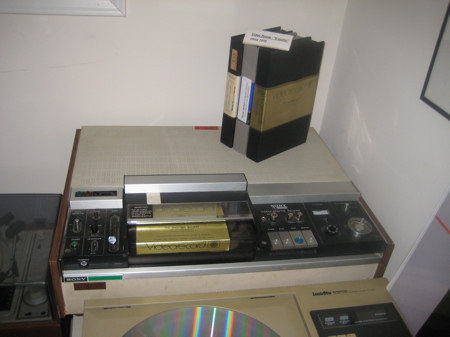
First generation VCR
Yeah, well, Mort invented all of that. The plastic bags with hanger/fasteners. The carousel display thing. I loved how he just mentioned that in passing – and even though Mort gave away all his movies to schools and libraries over the years, I’m pretty sure he made a few bucks off of these ancillary products along the way.
I love Mort Schindel.
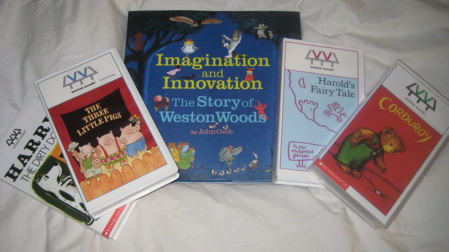
![]()

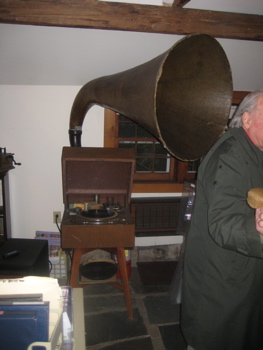
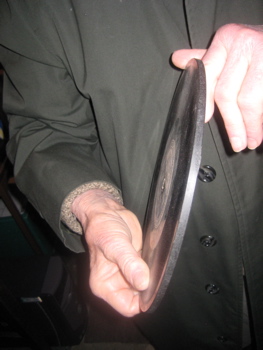
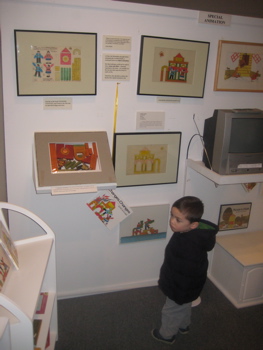
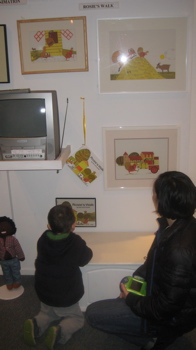
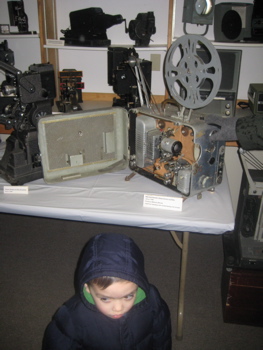
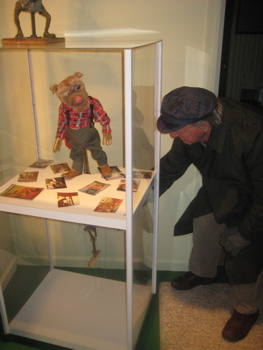
 Barry Smith says
Barry Smith says
February 1, 2014 at 12:06 amI am Barry Smith, son of Barbara and & Gayle Smith of Weston. Barbara worked for Mort many years and Gayle was the person that did the mechanics for the busses used for the mobile movie theaters. The lead-in of the bus theaters my father can be seen driving.
If Mort would like to see my brother & I we would be most iterested.
Please forward my email to whomever is involved with Weston Woods Studios; we could have something to contribute.
Barry
 Yuan Ma says
Yuan Ma says
December 25, 2018 at 12:34 amI am a big fan of picture books due to vast reading and exploring with my kids. So it’s quite inevitable that I get to know Morton Schindel and Weston Woods Studios. Really would love to visit the place. They are really modest, doing all those work and I can’t find a lot of information about them.
And thank you for posting all the museum photos. Greetings from China.
 M says
M says
December 30, 2018 at 8:50 amWhat a lovely visit you had! I worked for WW in the late 80s for a short while after graduating high school. Even high school me knew how special the place was, but I didn’t appreciate just how groundbreaking until recently. Thanks for this excellent post!